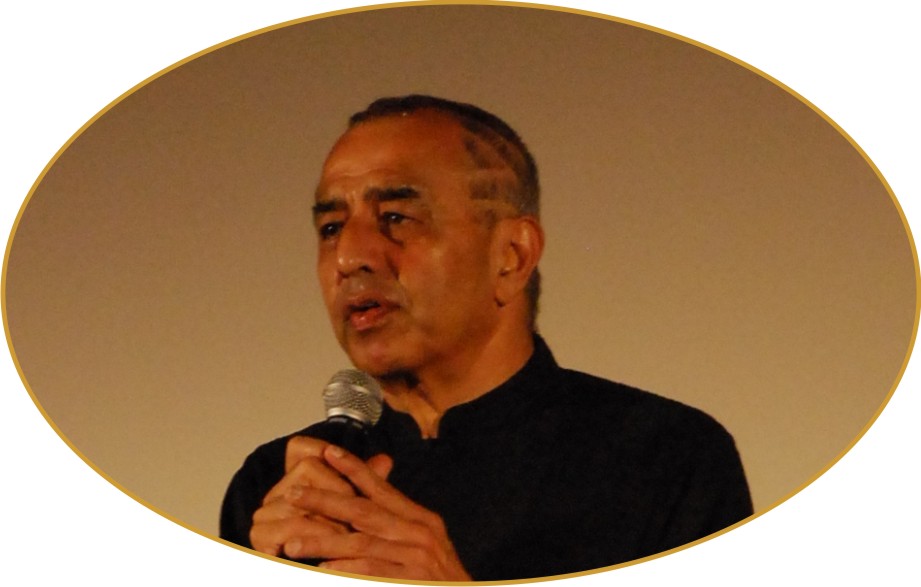
Astad Deboo, a name to reckon with
in Indian contemporary dance, is a man with a highly dynamic and individualistic
dance style. An innovator par excellence, he blends Indian classical
dance forms of Kathak and Kathakali with the modern dance techniques
to create his own unique style. His illustrious career has spanned four
decades and has won him several accolades; the most coveted being the
Padma Shri.
Recently, IIT Kanpur got a taste of his dynamism. As part of the ongoing
Golden Jubilee celebrations, Astad Deboo gave us two scintillating performances
- Breaking Boundaries and Rhythm Divine - with his troupe.
First performance staged was Breaking Boundaries, his latest production
featuring the talented street children from Salaam Balak trust (an NGO
that rescues street kids and rehabilitates them). The 70-minute performance
had five interwoven pieces exploring the evolution of life. The entire
dance sequence was a successful attempt to fathom unexplored dimensions
in space and time. Amidst the impatient darkness of the auditorium the
dancers occupied their positions onstage when the somber music started
to play. The dance began with children performing suave body movements
resulting in different coherent formations. In the next three dance
pieces, we were offered an aesthetic treat of a highly synchronized
group dance but with each dancer making his/her own definite statement.
The audience was enthralled watching them break multitude of boundaries
of society, culture, and art. In the fourth piece, we had on stage Deboo
himself with the children performing to the soulful music composed by
Pt. Hariprasad Chaurasia.
In the last piece, music changed to a fast pace rhythm and so did the
dance. It opened with a one minute solo act by Deboo, dressed in black,
which took everyone by surprise and left us craving for more. He was
later joined by rest of his troupe, who finished the performance charging
up the ambience with vibrance and fulfillment.
The following day another mesmerizing performance was showcased titled
Rhythm Divine, a collaboration with the Pung cholom drummers of Manipur.
The performance began slowly with classical background music. And then
the dancers picked up the pace - with perfect synchronization producing
rhythms by tapping the hands on body and floor with full force. What
followed was visual poetry - music and dance of the drummers and Astad
Deboo who complemented them with emoting fingers, body, and eyebrows.
In this 70-minute dance performance, drums entered the scene only at
the 60th minute and all of sudden the entire auditorium was reverberating
with loud sounds.
At a time when Indian dance scene was not open to innovations Astad
Deboo embarked on a journey to introduce contemporary dance to the Indian
audience and the journey hasn't ended yet. He shows no signs of retiring.
In fact, he is constantly exploring and collaborating with new artists.
Excerpts from an interview with Astad Deboo
during his recent visit to IIT Kanpur.
Is it the first time that you are performing
in an IIT and how has been the experience of performing among the technocrats?
Well, this is the second time. The experience has been good except that
there were many students in the audience when I performed earlier. And
they grew restless as the show didn't start on time and had to be calmed
down.
Why did you choose to name your dance piece
as 'Breaking Boundaries'?
Many boundaries have been broken. Boundaries were broken when these
kids ran away from their homes, then they were picked up by Salaam Balak
Trust. They also broke boundaries of their talent and existence through
this dance. That's why I chose this title.
What were the challenges that you faced while
working with these kids?
Well, these kids only knew Bollywood dance. Therefore, it was a challenge
to introduce them to this new dance form. Often they would ask 'Is this
also some kind of dance form' (one piece has been choreographed on narrow
benches). But they all were eager to learn so were highly receptive.
How do you think the lives of these kids have
been impacted?
Of course there life has been impacted. Anyone who works with me is
impacted. These kids have learnt a lot and have gained confidence. Many
of them are working professionally in different streams (Deboo's face
lights up with a spark while talking about these kids).
From working with international celebrities
to working with these unknown young amateurs. How has been the transition
for you as a person in terms of expereinces?
For me an artist is an artist. Their baggage doesn't come with me and
I don't bring my baggage also. For me it's my work and we work together
to create some interesting piece. These kids often say 'Arey, aap to
itne bade hain or hamare saath he khana khate hain'. Then I tell them
'Yeh bade ke baat nahin hai. Mein kalakar hoon or aap bhi kalakar hain'.
In order to get respect you need to give respect. There are famous people
who treat other people very shabbily and it just reflects so poorly
on them.
Your forthcoming projects?
At the moment, I have to show these works (Breaking Boundaries and Rhythm
Divine) in other metro cities. Than I am working on a duet with a Swiss
choreographer in Switzerland and that will open in October next year.
I am also looking at the Buddhists monks chanting from Arunachal and
Mysore. These are the two centers where Tibetan monks reside. I am also
interested in taking street children to Brazil as there is lot of street
culture.



